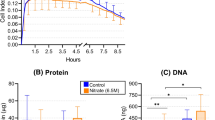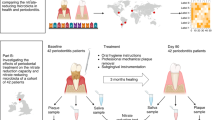Abstract
High concentrations of nitrite present in saliva (derived from dietary nitrate) may, upon acidification, generate nitrogen oxides in the stomach in sufficient amounts to provide protection from swallowed pathogens. We now show that, in the rat, reduction of nitrate to nitrite is confined to a specialized area on the posterior surface of the tongue, which is heavily colonized by bacteria, and that nitrate reduction is absent in germ-free rats. We also show that in humans increased salivary nitrite production resulting from nitrate intake enhances oral nitric oxide production. We propose that the salivary generation of nitrite is accomplished by a symbiotic relationship involving nitrate-reducing bacteria on the tongue surface, which is designed to provide host defence against microbial pathogens in the mouth and lower gut. These results provide further evidence for beneficial effects of dietary nitrate.
This is a preview of subscription content, access via your institution
Access options
Subscribe to this journal
Receive 12 print issues and online access
$209.00 per year
only $17.42 per issue
Buy this article
- Purchase on Springer Link
- Instant access to full article PDF
Prices may be subject to local taxes which are calculated during checkout
Similar content being viewed by others
References
Forman, D., Al-Dabbagh, S. & Doll, R. Nitrates, nitrites and gastric cancer in Great Britain. Nature 313, 620–625 (1985).
Knight, T.M. et al. Nitrate and nitrite exposure in Italian populations with different gastric cancer rates. Int. J. Epidemiol. 19, 510–515 (1990).
Sugimura, T., Fujimura, S. & Baba, T. Tumour production in the glandular stomach of the rat by N-methyl-N′-nitro-N-nitrosoguanidine. Cancer Res. 30, 455–465 (1970).
Hegesh, E. & Shiloah, J. Blood nitrates and infantile methaemoglobinaemia. Clin. Chim. Acta 125, 107–115 (1982).
Tannenbaum, S.R., Weisman, M. & Fett, D. The effect of nitrate intake on nitrite formation in human saliva. Food Cosmet. Toxicol. 14, 549–552 (1976).
Spiegelhalder, B., Eisenbrand, G. & Preussmann, R. Influence of dietary nitrate on nitrite content of human saliva: Possible relevance to in vivo formation of N-nitroso compounds. Food Cosmet. Toxicol. 14, 545–548 (1976).
Ishiwata, H., Tanimura, A. & Ishidate, M. Studies on in vivo formation of nitroso compounds: Nitrite and nitrate concentrations in human saliva collected from salivary ducts. J. Food Hyg. Soc. Jap. 16, 89–92 (1975).
Sasaki, T. & Matano, K. Formation of nitrite from nitrate at the dorsum linguae. J. Food. Hyg. Soc. lap. 20, 363–369 (1979).
Haddock, B.A. & Jones, C.W. Bacterial respiration. Bacterial. Rev. 41, 47–99 (1977).
Benjamin, N. et al. Stomach NO synthesis. Nature 368, 502 (1994).
Klebanoff, S.J. Reactive nitrogen intermediates and antimicrobial activity: Role of nitrite. Free Radical Biol. Med. 14, 351–360 (1993).
Mancinelli, R.L. & McKay, C.P. Effects of nitric oxide and nitrogen dioxide on bacterial growth. Appl. Environ. Microbiol. 46, 198–202 (1983).
Lundberg, J.O.N., Weitzberg, E., Lundberg, J.M. & Alving, K. Intragastric nitric oxide production in humans: Measurements in expelled air. Gut 35, 1543–1546 (1994).
Dougall, H., Smith, L., Duncan, C. & Benjamin, N. The effect of a broad spectrum antibiotic on salivary nitrite concentrations: An important mechanism of adverse reactions? Br. J. clin. Pharmac. 39, 460–462 (1995).
Gunsalus, R.P. Control of electron flow in Escherichia coli: Coordinated transcription of respiratory pathway genes. J. Bacterial. 174, 7069–7074 (1992).
Reddy, D., Lancaster, J.R. & Cornforth, D.P. Nitrite inhibition of Clostridium botulinum: Electron spin resonance detection of iron-nitric oxide complexes. Science 221, 769–770 (1983).
Wink, D.A. et al. DNA deaminating ability and genotoxicity of nitric oxide and its progenitors. Science 254, 1001–1003 (1991).
Beckman, J.S., Beckman, T.W., Chen, J., Marshall, P.A. & Freeman, B.A. Apparent hydroxyl radical production by peroxynitrite: Implications for endothelial injury from nitric oxide and superoxide. Proc. natn. Acad. Sci. U.S.A. 87, 1620–1624 (1990).
Hogg, N., Darley-Usmar, V.M., Wilson, M.T. & Moncada, S. Production of hydroxyl radicals from the simultaneous generation of superoxide and nitric oxide. Biochem. J. 281, 419–424 (1992).
Williams, D.H.L. Nitrosation (Cambridge Univ. Press, Cambridge, 1988).
Neal, K.R., Brij, S.O., Slack, R.C.B., Hawkey, C.J. & Logan, R.F.A. Recent treatment with H2 antagonists and antibiotics and gastric surgery as risk factors for salmonella infection. Br. Med. J. 308, 176 (1994).
Whittle, B.J.R., Lopez-Belmonte, J. & Moncada, S. Regulation of gastric mucosal integrity by endogenous nitric oxide: Interactions with prostanoids and sensory neuropeptides in the rat. Br. J. Pharmac. 99, 607–611 (1989).
Desai, K.M., Sessa, W.C. & Vane, J.R. Involvement of nitric oxide in the reflex relaxation of the stomach to accommodate food or fluid. Nature 351, 477–479 (1991).
Jensen, M.E. & Wefel, J.S. Human plaque pH responses to meals and the effects of chewing gum. Br. Dental. J. 167, 204–208 (1989).
Walker, A.M., Jick, H. & Porter, J. Drug-related superinfection in hospitalized patients. JAMA 242, 1273–1275 (1979).
Caldwell, J.R. & Cluff, L.E. Adverse reactions to antimicrobial agents. JAMA 230, 77–80 (1974).
Wennerholm, K. et al. Effect of xylitol and sorbitol in chewing-gums on mutans streptococci, plaque pH and mineral loss of enamel. Caries Res. 28, 48–54 (1994).
Braun, C. & Zumft, W.G. Marker exchange of the structural genes for nitric oxide reductase blocks the denitrification pathway of Pseudomonas stutzeri at nitric oxide. J. biol. Chem. 266, 22785–22788 (1991).
Bodis, S. & Haregewoin, A. Evidence for the release and possible neural regulation of nitric oxide in human saliva. Biochem. biophys. Res. Commun. 194, 347–350 (1993).
Edwards, D.A.W., Fletcher, K. & Rowlands, E.N. Antagonism between perchlorate, iodide, thiocyanate, and nitrate for secretion in human saliva. Lancet 498–499 (1954).
Sobala, G.M. et al. Ascorbic acid in the human stomach. Gastroenterology 97, 357–363 (1989).
Ministry of Agriculture Fisheries and Food. Food surveillance paper No. 20: Nitrate, nitrite and N-nitroso compounds in food. 7 (HMSO Books, London, 1987).
Ruddell, W.S.J., Blendis, L.M. & Walters, C.L. Nitrite and thiocyanate in gastric juice. Gut 17, 401 (1976).
Tannenbaum, S.R., Sinskey, A.J. & Bishop, W. Nitrite in human saliva: Its possible relationship to nitrosamine formation. J. natn. Cancer Inst. 53, 79–84 (1974).
Donahoe, W.E. Cyanosis in infants with nitrates in drinking water as a cause. Paediatrics 3, 308–311 (1949).
Rider, B.F. & Mellon, M.G. Colorimetric determination of nitrites. Ind. Engng Chem. 18, 96–99 (1946).
Stevens, A. Gram Method. in Theory and Practice of Histological Techniques (eds Bancroft, J.D. & Stevens, A.) 290–293 (Churchill Livingstone, London, 1990).
Gundersen, J.G. Notes on the estimation of the numerical density of arbitrary profiles. J. Microsc. 111, 219–223 (1977).
Author information
Authors and Affiliations
Rights and permissions
About this article
Cite this article
Duncan, C., Dougall, H., Johnston, P. et al. Chemical generation of nitric oxide in the mouth from the enterosalivary circulation of dietary nitrate. Nat Med 1, 546–551 (1995). https://doi.org/10.1038/nm0695-546
Received:
Accepted:
Published:
Issue Date:
DOI: https://doi.org/10.1038/nm0695-546
This article is cited by
-
Salivary elemental signature of dental caries: a systematic review and meta-analysis of ionomics studies
Odontology (2024)
-
From nitrate to NO: potential effects of nitrate-reducing bacteria on systemic health and disease
European Journal of Medical Research (2023)
-
Nitrate attenuates cisplatin-induced acute kidney injury by promotion of mitophagy and reduction of oxidative stress
Current Medicine (2023)
-
Influence of acute dietary nitrate supplementation timing on nitrate metabolism, central and peripheral blood pressure and exercise tolerance in young men
European Journal of Applied Physiology (2023)
-
Protective roles of inorganic nitrate in health and diseases
Current Medicine (2022)



